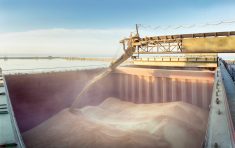RED DEER — Risk management specialists hope a project that would predict the risk of flooding in southern Alberta will receive financial approval.
The $2 million risk analysis model will use existing water, soil and drought data to build a computer model that will predict flooding, said Rick McConnell, a director with Dymac Risk Management Solutions.
The model will simulate water movement and show how too much or not enough moisture will affect farms, buildings and cities, McConnell told the Alberta Federation of Agriculture meeting.
Project organizers are hoping to access money from the federal government’s Growing Forward 2 Agricultural Risk fund.
Read Also

U.S. grains: Soybean prices rise as China-U.S. truce assessed
Chicago soybean prices rose on Wednesday, recovering some of the previous session’s losses, as Beijing’s confirmation that it was cutting tariffs on U.S. farm goods put attention back on a trade truce between the countries.
The first year of the project would be spent entering hydrological data into the computer to build the database, which can then be shown to insurance companies to help calculate flood risk.
McConnell said the flood maps can show how many times a field has been too wet to seed during seeding, which allows insurance companies to offer flood risk insurance.
“We’re proving the model in Alberta now,” he said.
“Once we prove it works, it can go anywhere in the world. There are multiple uses for this project, but we need GF2 funding to get this project up and going.”
Federation president Lynn Jacobson said the benefits of predicting flood risk in rural areas will have huge benefits to farmers, but building the computer model and proving that it can accurately predict water and drought events is crucial.
“Providing the model is foremost.”
McConnell said the project has caught the eye of insurance companies, which will be able to forecast flood damage and offer policies based on the computer model.
“Flooding is such a big interest,” he said.
“This is not just a research project. The project is a way to develop practical solutions.”
The computer model would be able to assess flood and drought risk and allow insurance companies to offer contracts based on the risk.
The first project would input water data from a variety of sources in the South Saskatchewan River Basin and begin drought and flood modelling.
Aquanty, the Ontario based hydrology company that would operate the project, uses its forecasting model in Ontario to monitor water events and has done hydrology research work in Alberta’s Athabasca River basin for oil company Suncor.
Aquanty analyst Steven Fry said a berm could be built in the simulation model to see if it would eliminate the risk of flooding, or a dam could be built to see how it would mitigate flooding.
“It builds a model for insurance purposes,” he said.
“Insurance folks are fixated on accuracy. They’re heavily model dependent.”
Frey said the model could design synthetic landscapes and simulate mitigation strategies. You can keep going through the designs, and you haven’t had to lift a shovel or move earth with a bulldozer.”
Dan Mazier with Keystone Agricultural Producers said Manitoba needs access to the program once it is built to help farmers hit hard by flooding.
“We need this data badly,” said Mazier.
Mary.macarthur@producer.com














